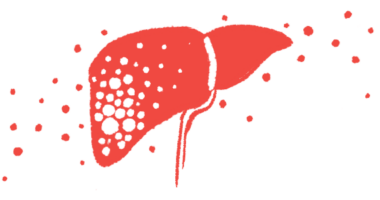Close monitoring urged for weight gain with Kaftrio in CF patients
Study from Norway warns against unhealthy diets while on therapy

While treatment with Kaftrio (elexacaftor/tezacaftor/ivacaftor) helps people with cystic fibrosis (CF) gain weight, a tendency toward unhealthy diets may pose new risks for patients — warranting “close monitoring and interventions to prevent excessive weight gain” — a study from Norway reports.
People with CF in the European nation who were taking Kaftrio — sold as Trikafta in the U.S. — tended to have low fiber intake and high saturated fat intake, the study found. These eating habits were similar to those seen in the general population in Norway, but the researchers noted that they generally don’t align well with national recommendations.
Further, the unhealthy diet seen for many CF patients in the country puts these individuals at risk of excessive weight gain, according to the researchers.
“While overall nutritional status has improved following [Kaftrio] treatment, proactive measures, particularly in dietary guidance, are imperative to prevent the current trends from escalating,” the team wrote, adding that closer monitoring and some “interventions to improve diet quality should be a priority moving forward.”
The study, “Diet habits and body composition in people with cystic fibrosis under elexacaftor/tezacaftor/ivacaftor treatment – A longitudinal, observational study,” was published in the journal Clinical Nutrition Open Science.
CF is a genetic disease in which the body produces abnormally thick and sticky mucus in various organs. Symptoms of CF include digestive issues, such as difficulty putting on weight.
Kaftrio, sold as Trikafta in US, helps CF patients increase energy intake
While historically nutritional goals were to increase energy intake and body weight in people with CF, more recent guidelines from the European Society for Parenteral and Enteral Nutrition focus on periodically assessing body composition. Nutritional therapy is typically a part of a CF treatment program.
“Instead of focusing mainly on body weight and increased energy intake, as in the past, the guidelines recommend nutritional interventions and more focus on a healthier diet to improve overall nutritional status and avoid obesity,” the researchers wrote.
The team noted that the Nordic Nutrition Recommendations call for a healthy diet, specifically one that’s “high in vegetables, fruit, whole grains, fish, low-fat dairy, and legumes and low in red and processed meats, sugar-sweetened beverages, high sugar foods, and refined grains.”
In this small study, a team from the University of Bergen and Oslo University Hospital investigated the eating habits and body composition of people with CF on Kaftrio treatment. Their work involved 11 women and 16 men, with a mean age of 35.
First, the scientists examined body mass index (BMI), a measure of body fat that takes into account weight and height. Based on BMI cutoffs, 70% of participants — 19 in all — were at a normal weight, while 22% (a total of six patients) were overweight. One patient each (4%) was obese or underweight.
The researchers noted, however, that “BMI score alone fails to provide comprehensive insight into body composition, a factor that is likely to influence the risk of mortality and morbidity, especially in individuals with chronic inflammatory diseases such as CF.” Morbidity refers to having a specific condition, while mortality refers to the number of deaths caused by that condition.
To account for this, the team also examined more direct measures of body fat. Among them, the fat-free mass index, which calculates the mass of muscles and other nonfat tissues relative to height, was low in five participants (19%).
Patients’ diets found to ‘not align with dietary recommendations’
The researchers further interviewed participants, twice, about their diet on the prior day. Overall, about 15% of the patients’ daily energy intake came from saturated fats. This type of fats can increase cholesterol levels and a person’s risk of heart disease.
A total of 20 participants had a daily saturated fat intake that exceeded the recommended intake for the general Nordic population. Also, the participants consumed a median of 22g of dietary fiber per day — less than the recommended minimum of 25g.
“Given the challenges in meeting energy needs for [people with] CF, their diet likely comprises energy-dense foods, including foods high in saturated fat and added sugar, while low in dietary fiber,” the team wrote.
The intake of vegetables, fruits, and berries was also low at 283 grams per day — the minimum recommended intake is 500 grams daily. Most participants (82%) didn’t meet the minimum recommendation in this category.
About half of the participants had low intake of fish and seafood, and 67% had high intake of red meat. Results for milk and dairy were less consistent, with 48% of participants below the daily recommended ranges and 48% above.
As a whole, “the observed dietary patterns do not align with dietary recommendations, mirroring trends seen in the general population,” the researchers wrote. “This raises concerns about their potential risk of facing similar lifestyle-related diseases as seen in the general population.”
It’s imperative to emphasize the significance of healthy fat sources and prioritize unsaturated fats to reduce the risk of non-communicable diseases such as cardiovascular diseases.
To counteract these threats, a nuanced dietary approach may be needed for people living with the genetic disease, the researchers noted.
“Compared to the general population, [people with] CF may still require a higher fat intake to meet elevated energy demands. Therefore, it’s imperative to emphasize the significance of healthy fat sources and prioritize unsaturated fats to reduce the risk of non-communicable diseases such as cardiovascular diseases,” the team wrote.
As study limitations, the investigators noted that they did not have data from before Kaftrio therapy began, and their work involved a relatively small number of participants. That small number likely underlies their finding that the prevalence of diabetes in women was “unusually high,” and not an actual population trend, the team noted.
Nonetheless, the researchers concluded that their “dietary habit assessments reveal patterns of high intakes of saturated fat, and a low dietary fiber intake, contradicting the principles of a healthy diet.”









